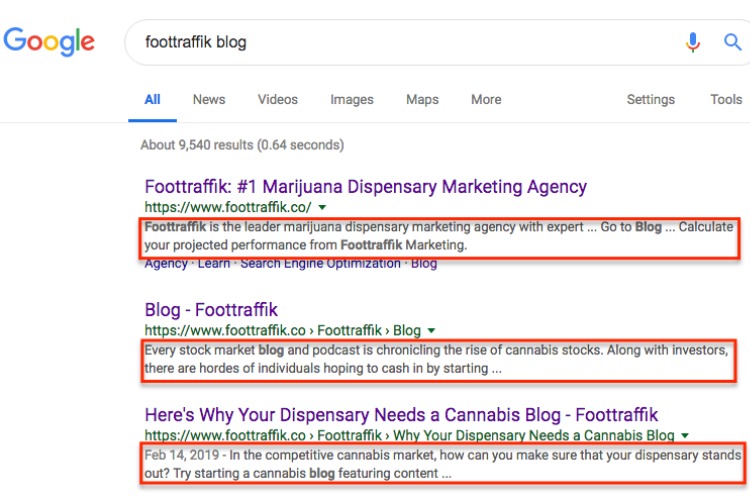How to Write Meta Descriptions for Cannabis Dispensaries: SEO Best Practices

A meta description is a form of advertising for your page. The content should be unique, informative, contain relevant keywords and have a strong CTA.
Where to add the Meta Description:
You can add a meta description in the <head> section of your site’s HTML. It should look something like this:
<head>
<meta name=”description” content=”Here is a precise description of my awesome cannabis dispensary.”>
</head>
If you’re using WordPress or a similar user-friendly platform, scroll to the bottom of the page or post and customize the meta description there.
Length
There is no “perfect number” when it comes to the length of a meta description. A meta description should be anywhere between 135-200 characters (the most updated limit set by Google). In most cases, if you go over the upper limit, your meta description will be cut short by Google and not displayed correctly like in the example below.
Keywords
Make sure your most important keywords for your dispensary page are inserted into the meta description. Search engines will bold the keyword within your meta description, therefore driving up click-through rates.
From the local perspective, make sure to include the city or location in which that page is targeting and, if you can, near the keywords within the meta description.
Call to Action
A meta description should encourage the user to take action and visit your website. The call-to-action is your sales manuscript and can increase your site’s click-through rates. Below, Road Runner Sports does an excellent job using a short call-to-action at the end of their meta description
Duplicate Cannabis Dispensary Meta Descriptions
Even though meta descriptions don’t have a direct impact on your rankings, they still play a large role in the overall user experience. With Google’s algorithm continuing to reward great user experience, having duplicate meta descriptions means that the user isn’t seeing relevant information. If you do not fix this problem, Google will assume your website isn’t doing its best to prioritize user experience which can have negative consequences. If you are tempted to create a duplicate meta description, you’re better off leaving the description empty and allowing Google to pick a snippet from the page containing the keyword used in a search.
Using AI Tools To Generate Meta Descriptions
The integration of Artificial Intelligence (AI) in the realm of SEO is revolutionizing the way we craft meta descriptions. One of the primary ways AI aids in this is through sophisticated keyword analysis. It can sift through vast data sets to pinpoint high-ranking keywords pertinent to the content and seamlessly weave them into the meta description, enhancing search visibility. Furthermore, AI’s capability to summarize content ensures that meta descriptions are accurate reflections of the page’s core message.
Sentiment analysis, another AI forte, crafts meta descriptions that resonate with the tone and mood of the content, making them more enticing to potential readers. Predictive analytics, on the other hand, can forecast which descriptions are likely to garner higher click-through rates based on past data and user behavior. This predictive prowess is further amplified when AI automates A/B testing, determining the meta descriptions that outperform others in terms of engagement.
Personalization is another frontier where AI shines. By generating meta descriptions tailored to user behavior and search history, AI ensures heightened relevance for individual users. Additionally, AI’s ability to conduct competitor analysis can spotlight opportunities to distinguish one’s content in search results. With the aid of advanced Natural Language Processing (NLP), AI ensures that these descriptions are not only optimized for search engines but also resonate with a human touch.
Practicalities aren’t overlooked either. AI ensures meta descriptions adhere to optimal character limits, ensuring full visibility in search results. For businesses with a global footprint, AI’s multilingual support is invaluable, crafting optimized descriptions for diverse regions. Lastly, the real-time adaptability of AI, combined with its integration with analytics tools, means meta descriptions are always in tune with current best practices and performance metrics. In essence, AI is not just a tool but a dynamic partner in crafting SEO-optimized meta descriptions for the modern web.
Rich Snippets
Schema markup allows you to add elements to the area around the meta description to increase the page’s appeal. These elements would include anything from star ratings, customer ratings, product information, calorie counts, etc. You’ll want to invest in learning how to implement rich snippets. Below is an excellent example of rich snippets alongside a meta description.





